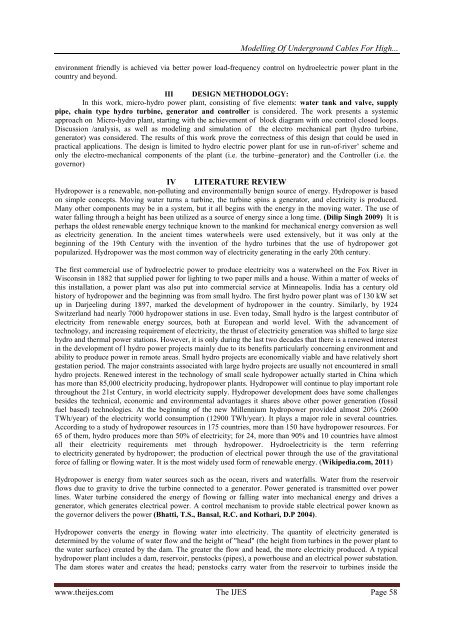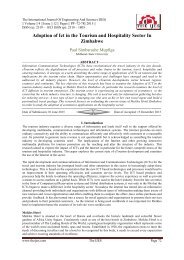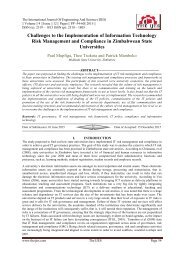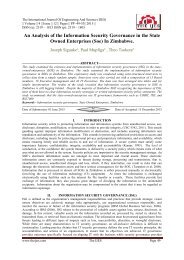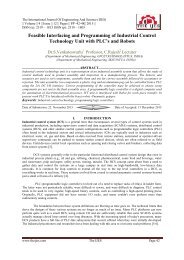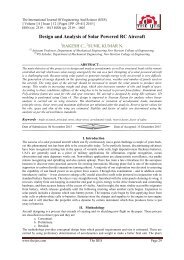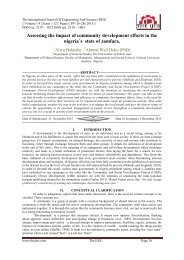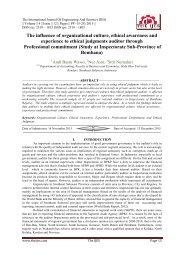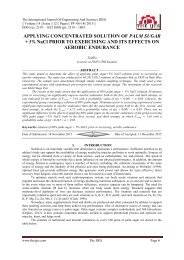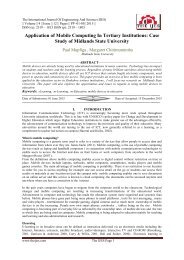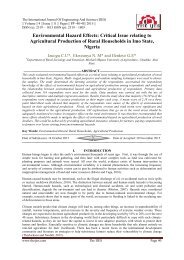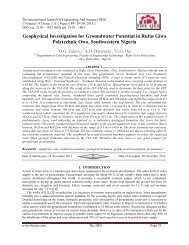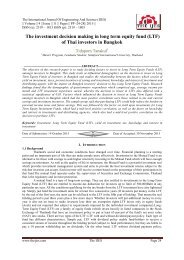Modelling Of Underground Cables for High Voltage Transmission
Create successful ePaper yourself
Turn your PDF publications into a flip-book with our unique Google optimized e-Paper software.
<strong>Modelling</strong> <strong>Of</strong> <strong>Underground</strong> <strong>Cables</strong> For <strong>High</strong>...<br />
environment friendly is achieved via better power load-frequency control on hydroelectric power plant in the<br />
country and beyond.<br />
III DESIGN METHODOLOGY:<br />
In this work, micro-hydro power plant, consisting of five elements: water tank and valve, supply<br />
pipe, chain type hydro turbine, generator and controller is considered. The work presents a systemic<br />
approach on Micro-hydro plant, starting with the achievement of block diagram with one control closed loops.<br />
Discussion /analysis, as well as modeling and simulation of the electro mechanical part (hydro turbine,<br />
generator) was considered. The results of this work prove the correctness of this design that could be used in<br />
practical applications. The design is limited to hydro electric power plant <strong>for</strong> use in run-of-river’ scheme and<br />
only the electro-mechanical components of the plant (i.e. the turbine–generator) and the Controller (i.e. the<br />
governor)<br />
IV LITERATURE REVIEW<br />
Hydropower is a renewable, non-polluting and environmentally benign source of energy. Hydropower is based<br />
on simple concepts. Moving water turns a turbine, the turbine spins a generator, and electricity is produced.<br />
Many other components may be in a system, but it all begins with the energy in the moving water. The use of<br />
water falling through a height has been utilized as a source of energy since a long time. (Dilip Singh 2009) It is<br />
perhaps the oldest renewable energy technique known to the mankind <strong>for</strong> mechanical energy conversion as well<br />
as electricity generation. In the ancient times waterwheels were used extensively, but it was only at the<br />
beginning of the 19th Century with the invention of the hydro turbines that the use of hydropower got<br />
popularized. Hydropower was the most common way of electricity generating in the early 20th century.<br />
The first commercial use of hydroelectric power to produce electricity was a waterwheel on the Fox River in<br />
Wisconsin in 1882 that supplied power <strong>for</strong> lighting to two paper mills and a house. Within a matter of weeks of<br />
this installation, a power plant was also put into commercial service at Minneapolis. India has a century old<br />
history of hydropower and the beginning was from small hydro. The first hydro power plant was of 130 kW set<br />
up in Darjeeling during 1897, marked the development of hydropower in the country. Similarly, by 1924<br />
Switzerland had nearly 7000 hydropower stations in use. Even today, Small hydro is the largest contributor of<br />
electricity from renewable energy sources, both at European and world level. With the advancement of<br />
technology, and increasing requirement of electricity, the thrust of electricity generation was shifted to large size<br />
hydro and thermal power stations. However, it is only during the last two decades that there is a renewed interest<br />
in the development of l hydro power projects mainly due to its benefits particularly concerning environment and<br />
ability to produce power in remote areas. Small hydro projects are economically viable and have relatively short<br />
gestation period. The major constraints associated with large hydro projects are usually not encountered in small<br />
hydro projects. Renewed interest in the technology of small scale hydropower actually started in China which<br />
has more than 85,000 electricity producing, hydropower plants. Hydropower will continue to play important role<br />
throughout the 21st Century, in world electricity supply. Hydropower development does have some challenges<br />
besides the technical, economic and environmental advantages it shares above other power generation (fossil<br />
fuel based) technologies. At the beginning of the new Millennium hydropower provided almost 20% (2600<br />
TWh/year) of the electricity world consumption (12900 TWh/year). It plays a major role in several countries.<br />
According to a study of hydropower resources in 175 countries, more than 150 have hydropower resources. For<br />
65 of them, hydro produces more than 50% of electricity; <strong>for</strong> 24, more than 90% and 10 countries have almost<br />
all their electricity requirements met through hydropower. Hydroelectricity is the term referring<br />
to electricity generated by hydropower; the production of electrical power through the use of the gravitational<br />
<strong>for</strong>ce of falling or flowing water. It is the most widely used <strong>for</strong>m of renewable energy. (Wikipedia.com, 2011)<br />
Hydropower is energy from water sources such as the ocean, rivers and waterfalls. Water from the reservoir<br />
flows due to gravity to drive the turbine connected to a generator. Power generated is transmitted over power<br />
lines. Water turbine considered the energy of flowing or falling water into mechanical energy and drives a<br />
generator, which generates electrical power. A control mechanism to provide stable electrical power known as<br />
the governor delivers the power (Bhatti, T.S., Bansal, R.C. and Kothari, D.P 2004).<br />
Hydropower converts the energy in flowing water into electricity. The quantity of electricity generated is<br />
determined by the volume of water flow and the height of "head" (the height from turbines in the power plant to<br />
the water surface) created by the dam. The greater the flow and head, the more electricity produced. A typical<br />
hydropower plant includes a dam, reservoir, penstocks (pipes), a powerhouse and an electrical power substation.<br />
The dam stores water and creates the head; penstocks carry water from the reservoir to turbines inside the<br />
www.theijes.com The IJES Page 58


